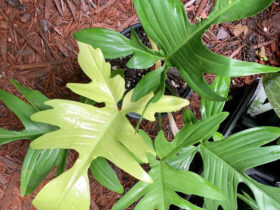Introduction
Purple Daydream Loropetalum, also known as Chinese Fringe Flower, is a popular and versatile evergreen shrub that adds color and texture to gardens and landscapes. This stunning plant is known for its vibrant purple foliage and delicate, fringed flowers that bloom in spring. In recent years, it has gained popularity among gardeners and landscapers for its low maintenance requirements and ability to thrive in various conditions. In this comprehensive guide, we will explore the characteristics, planting and care, landscape design uses, and potential problems associated with Purple Daydream Loropetalum.
Description and Characteristics
Purple Daydream Loropetalum is a compact, evergreen shrub that belongs to the family Hamamelidaceae. It is native to Southeast Asia, particularly China and Japan. Here are some key features of this attractive plant:
- Foliage: The most striking feature of Purple Daydream Loropetalum is its deep purple, almost burgundy, foliage. The leaves are oval-shaped and grow densely on the branches, providing year-round color and interest.
- Flowers: In spring, the plant produces clusters of delicate, fringe-like flowers. These flowers are usually pink or white, contrasting beautifully with the dark foliage. The blooms attract pollinators such as bees and butterflies, adding life and movement to your garden.
- Growth Habit: Purple Daydream Loropetalum has a compact, mounding growth habit, typically reaching a height and spread of 2-3 feet. This makes it an excellent choice for small gardens, borders, and container planting.
- Ideal Growing Conditions: This plant thrives in well-draining, acidic soil with a pH range of 5.5-6.5. It prefers partial to full sun, with at least 4-6 hours of direct sunlight daily. Purple Daydream Loropetalum is hardy in USDA zones 7-10, tolerating temperatures down to 0°F (-18°C).
Overall, Purple Daydream Loropetalum is a versatile and attractive plant that adds a pop of color to any garden or landscape. Its combination of vivid foliage, delicate flowers, and compact growth habit make it a popular choice among gardeners and landscapers alike.
Planting and Care
To ensure the successful growth and maintenance of your Purple Daydream Loropetalum, follow these planting and care guidelines:
- Planting: Choose a location with well-draining soil and partial to full sun exposure. Dig a hole twice as wide and just as deep as the root ball, then place the plant in the hole, ensuring the top of the root ball is level with the surrounding soil. Fill in the hole with soil, and gently tamp it down to remove air pockets. Water the plant thoroughly after planting[^1^].
- Watering: Purple Daydream Loropetalum prefers consistent moisture but does not tolerate waterlogged soil. Water the plant deeply and regularly, allowing the soil to dry slightly between waterings[^1^].
- Fertilizing: Apply a slow-release, acid-forming fertilizer in early spring to promote healthy growth and vibrant foliage. Follow the package instructions for the appropriate application rate[^1^].
- Pruning: Prune Purple Daydream Loropetalum in late winter or early spring to maintain its shape and encourage branching. Remove any dead or damaged branches, and trim back any excessively long or unruly growth[^1^].
- Pest and Disease Control: Keep an eye out for common pests such as aphids, scale insects, and spider mites. Treat any infestations with insecticidal soap or horticultural oil. Additionally, ensure proper watering and well-draining soil to prevent root rot and other fungal diseases[^1^].
By following these planting and care guidelines, you can help your Purple Daydream Loropetalum thrive and maintain its vibrant color and attractive appearance.
Landscape Design and Uses
Purple Daydream Loropetalum is a versatile plant that can be incorporated into various landscape designs and serves multiple purposes. Here are some ideas for incorporating this attractive shrub into your garden or landscape:
- Borders and Edging: With its compact size and mounding growth habit, Purple Daydream Loropetalum is an excellent choice for creating colorful borders and edging in your garden. Plant them along walkways, driveways, or around garden beds to create a vibrant, eye-catching display.
- Foundation Plantings: Use this evergreen shrub as a foundation planting around your home or other structures. Its year-round color and attractive foliage will help to enhance the overall appearance of your property.
- Mass Planting: Plant multiple Purple Daydream Loropetalum shrubs together to create a stunning mass planting. This can be particularly effective on slopes or in large garden beds where the vibrant foliage will create a striking visual impact.
- Container Gardening: Due to its compact size, Purple Daydream Loropetalum is suitable for container gardening. Plant it in a decorative pot or planter and place it on your patio, deck, or balcony to add color and interest to your outdoor living space.
- Companion Plants: Pair Purple Daydream Loropetalum with plants that contrast or complement its deep purple foliage. Some great companion plants include:
- Yellow or gold-foliaged plants (e.g., Golden Euonymus, Gold Mop Cypress)
- Silver-foliaged plants (e.g., Artemisia, Dusty Miller)
- Plants with bright, colorful flowers (e.g., Azaleas, Daylilies, Roses)
By incorporating Purple Daydream Loropetalum into your landscape design, you can create a visually appealing and dynamic garden that will be enjoyed throughout the year.
Potential Problems and Solutions
Although Purple Daydream Loropetalum is a relatively low-maintenance plant, it can still face some common issues. Here are potential problems and their respective solutions:
- Pests: Aphids, scale insects, and spider mites can infest Purple Daydream Loropetalum. To treat these infestations, use insecticidal soap or horticultural oil, following the manufacturer’s instructions. Regularly inspect your plant for signs of pests, and treat promptly to prevent extensive damage.
- Diseases: Root rot and fungal diseases can affect Purple Daydream Loropetalum, particularly in poorly draining soil or when overwatered. To prevent these issues, ensure that your plant is in well-draining soil and adjust your watering schedule to allow the soil to dry slightly between waterings. If you notice signs of disease, such as wilting or yellowing leaves, consult a local nursery or extension office for advice on treatment options.
- Nutrient Deficiencies: Purple Daydream Loropetalum may exhibit signs of nutrient deficiencies, such as yellowing leaves or poor growth, if it is not receiving adequate nutrients. Apply a slow-release, acid-forming fertilizer in early spring to provide the necessary nutrients for healthy growth and vibrant foliage.
- Winter Damage: In colder climates (USDA zones 7-8), Purple Daydream Loropetalum may experience winter damage, such as leaf scorch or branch dieback. To minimize winter damage, plant your Loropetalum in a sheltered location, protected from harsh winds, and consider applying a layer of mulch around the base of the plant to insulate the roots.
By being proactive in monitoring your Purple Daydream Loropetalum for potential issues and addressing them promptly, you can ensure that your plant remains healthy and vibrant throughout the year.
Conclusion
In conclusion, Purple Daydream Loropetalum is a versatile and attractive evergreen shrub that can add color and interest to various landscape designs. With its compact size, vibrant purple foliage, and low-maintenance requirements, it is a popular choice for borders, foundation plantings, mass plantings, and container gardening. By following the recommended planting and care guidelines, and addressing potential problems promptly, you can ensure the successful growth and maintenance of your Purple Daydream Loropetalum, creating a visually appealing and dynamic garden that can be enjoyed throughout the year.














Leave a Reply